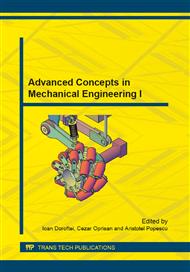[1]
J. A Cobano, J. Estremera, P. Gonzales de Santos, Location of legged robots in outdoor environment, Robotics and Autonomous Systems, Vol. 56 (2008) 751-761.
DOI: 10.1016/j.robot.2007.12.003
Google Scholar
[2]
I. Doroftei, Y. Baudoin, A concept of walking robot for humanitarian demining, Industrial Robot: An International Journal, Vol. 39, Iss: 5 (2012) 441-449.
DOI: 10.1108/01439911211249733
Google Scholar
[3]
M. Raibert, G. Nelson, R. Playter, BigDog, the Rough-Terrain Quadruped Robot, Proceedings of the 17th World Congress The International Federation of Automatic Control Seoul, Korea, July 6-11, 2008, pp.10822-10825.
DOI: 10.3182/20080706-5-kr-1001.01833
Google Scholar
[4]
M. Fujita. & H. Kitano, Development of an autonomous quadruped robot for robot entertainment, Autonomous Robots, 5 (1998) 7-20.
DOI: 10.1007/978-1-4615-5735-7_2
Google Scholar
[5]
Information on http: /spectrum. ieee. org/automaton/robotics/robotics-software/epfl-iit-cheetah-cub-quadruped-kmps.
Google Scholar
[6]
G. Carbone, M. Ceccarelli, Legged robotic systems, Cutting Edge Robotics, ARS Scientific Book, Wien, pp.553-576, (2005).
DOI: 10.5772/4669
Google Scholar
[7]
Information on http: /www-robotics. jpl. nasa. gov/systems.
Google Scholar
[8]
Information on http: /www. strandbeest. com.
Google Scholar
[9]
K. Komoda, H. Wagatsuma, A study of availability and extensibility of Theo Jansen mechanism toward climbing over bumps, The 21st Annual Conference of the Japanese Neural Network Society, December, 2011, P3, p.28.
Google Scholar
[10]
Information on https: /ujdigispace. uj. ac. za.
Google Scholar
[11]
S. Nansai, M. Rajesh Elarab, M. Iwasea, Dynamic Analysis and Modeling of Jansen Mechanism, Procedia Engineering 64 ( 2013 ) 1562 – 1571.
DOI: 10.1016/j.proeng.2013.09.238
Google Scholar
[12]
L. Marques , Advances in Mobile Robotics: Proceedings of the Eleventh International Conference on Climbing and Walking Robots and the Support Technologies for Mobile Machines, Coimbra, Portugal, 8-10 September 2008, World Scientific, New Jersey, (2008).
Google Scholar
[13]
F. Moldovan ,V. Dolga, Analysis of Jansen walking mechanism using CAD, Robotics and Automation System, vol. 166-167 of Solid State Phenomena, 2010, pp.297-302.
DOI: 10.4028/www.scientific.net/ssp.166-167.297
Google Scholar
[14]
F. Moldovan ,V. Dolga, C. Pop, Kinetostatic Analysis of an articulated walking mechanism, Mechanisms and Machine Science 3- Mechanisms, Transmissions and Applications, Springer Heilderberg, 2012, pp.103-111.
DOI: 10.1007/978-94-007-2727-4_9
Google Scholar
[15]
F. Moldovan ,V. Dolga, C. Pop, Synthesis of an articulated ten bar mechanism for building a walking robot, 8th IEEE International Symposium on Applied Computational Intelligence and Informatics, 2013, pp.365-370.
DOI: 10.1109/saci.2013.6608999
Google Scholar


